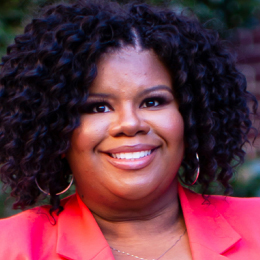The Experiences and Needs of Black Families Raising Children with Autism
Jamie N. Pearson, PhD, Assistant Professor of Special Education
Department of Teacher Education and Learning Sciences,
North Carolina State University

Despite the increase in autism among children across racial and ethnic backgrounds in recent years, Black families raising children with autism still face unique barriers to accessing and utilizing services. In fact, many Black children show signs of autism years before being identified. We know that early diagnosis and early intervention leads to more positive outcomes among children with autism, however, disparate access has created a specific need for Black families to have more equitable access to autism services and supports.
Children with autism may require high quality primary care, specialized care, complex and specialized educational child care needs, as well as social and recreational outlets that are often delivered via multidisciplinary teams. As such, primary care physicians, developmental pediatricians, special education teachers, speech language pathologists, and school psychologists are among the professionals who support families and children with autism. Among Black families, however, two common barriers include: gaining accurate and timely diagnoses and cultural dissonance between parents and professionals. Given the interdisciplinary nature of the teams of professionals who support children with autism, collaboration is key. It is important to address autism disparities among Black families in both home (i.e., early intervention), and school settings.
Home: Early Intervention
 Early intervention practitioners are those who provide early intervention services, such as physical therapy, behavioral therapy, medical services and nutritional services for children birth through three years. One of the primary goals of early intervention is to provide support, information and services to parents to enhance young childrens’ development and decrease the likelihood of delays in the future. Positive experiences for Black parents of children with autism are often promoted by partnership and advocacy, especially during early intervention services when they are available and accessible. Early intervention practitioners must build rapport, communicate effectively, and engage in cultural reciprocity in order to serve the needs of Black children with autism. Early intervention practitioners can adopt the following practices and strategies in order to be responsive to the needs of Black (and other historically marginalized) families with children with autism:
Early intervention practitioners are those who provide early intervention services, such as physical therapy, behavioral therapy, medical services and nutritional services for children birth through three years. One of the primary goals of early intervention is to provide support, information and services to parents to enhance young childrens’ development and decrease the likelihood of delays in the future. Positive experiences for Black parents of children with autism are often promoted by partnership and advocacy, especially during early intervention services when they are available and accessible. Early intervention practitioners must build rapport, communicate effectively, and engage in cultural reciprocity in order to serve the needs of Black children with autism. Early intervention practitioners can adopt the following practices and strategies in order to be responsive to the needs of Black (and other historically marginalized) families with children with autism:
- Cultural reciprocity. Practitioners can begin by identifying their own cultural values and beliefs. Then, assess the similarities and differences between their values and the values of the families served. Lastly, use this knowledge to build rapport and make informed decisions.
- Help parents feel empowered by having them define their own and their child’s strengths. Support families’ agency-building so they can better “activate” their empowerment
- Build families’ advocacy skills by helping parents understand the needs of their child and what services their child is entitled to; respect the parents’ role in advocacy.
- Parent-Professional Partnerships. Foster family and professional collaboration by building rapport and practicing responsive communication. Acknowledge and respect families’ cultural expectations.
Schools

Just like early interventionists, teachers and school-based practitioners can implement specific strategies to help address the challenges and needs of Black students and their families. One fundamental way that school-based professionals can build relationships with families of children with autism is to build rapport. Rapport-building is one of the most critical elements in creating a family-centered partnership. Rapport-building should include the following elements:
- Listening to parents. Take the time out to actually listen to the parents about their concerns and needs. Black families, in particular, often feel that their voices go unheard or dismissed.
- Getting to know the families. Take interest in the families’ culture and their experiences.
- Seeking to learn more about autism and autism best practices. A critical barrier to equitable services for Black children with autism is educators’ misunderstanding or misinterpretations of their behavior and communication.
- Recognizing that parents are experts as well. Educators should welcome and implement parent suggestions.
Teachers and school-based professionals can also meet the needs of Black children with autism through culturally responsive approaches. School-based professionals should understand that experiences and cultural norms vary across students, and they should respond to these differences in culturally appropriate ways. For example, the curricula and materials used in some school systems often do not meet the needs of children with autism, and are culturally biased. To create more culturally responsive classrooms and schools, educators can:
- Use cultural knowledge to guide curriculum, instructional strategies, the climate of the classroom, and relationships with students.
- Engage in cultural reciprocity, where educators reflect on their own values and beliefs, recognize how their values are similar or different from their students’, and use this understanding to make decisions.
- Challenge cultural and racial stereotypes and recognize that advocacy may look different in different cultures.
- Display empathy and understanding of these different cultural experiences. This might include connecting home and school experiences, implementing different instructional strategies to meet the needs of different learning styles, and incorporating multicultural information and experiences in instructional material.
Additionally, Black parents of children with autism have often identified communication with teachers as a significant barrier to adequate service delivery. Therefore, it is essential for teachers to foster strong communication with parents. Teachers can combat this challenge by implementing the following strategies:
- Considering many communication styles. There are many factors that shape the way parents are able to communicate, so be flexible.
- Considering tone and approach of communication. Highlight the students’ strengths and avoid talking down to parents.
- Establishing expectations. Develop expectations for school and home environments.
- Including paraprofessionals. Establish collaborative relationships between parents, teachers and paraprofessionals through effective communication.
Finally, in an effort to better support Black students with autism, professionals working in both home and school-based settings should adopt and embed culturally responsive strategies that will facilitate rapport-building, effective communication, and ultimately, help to dismantle some of the systemic inequities that create barriers for Black students with autism and their families.
Jamie Pearson, PhD is an Assistant Professor of Special Education in the Department of Teacher Education and Learning Sciences at North Carolina State University. Dr. Pearson developed FACES, a parent advocacy program designed to support African American families of children with autism. Her research focuses on: (a) investigating disparities in autism diagnoses, service access, and service utilization among minority families, (b) assessing the impact of parent-advocacy and empowerment training on family dynamics and child outcomes, and (c) building positive partnerships between educators and parents of children with disabilities.
To learn more about the FACES program click here, or visit: https://sites.google.com/ncsu.edu/facesprogram/home
